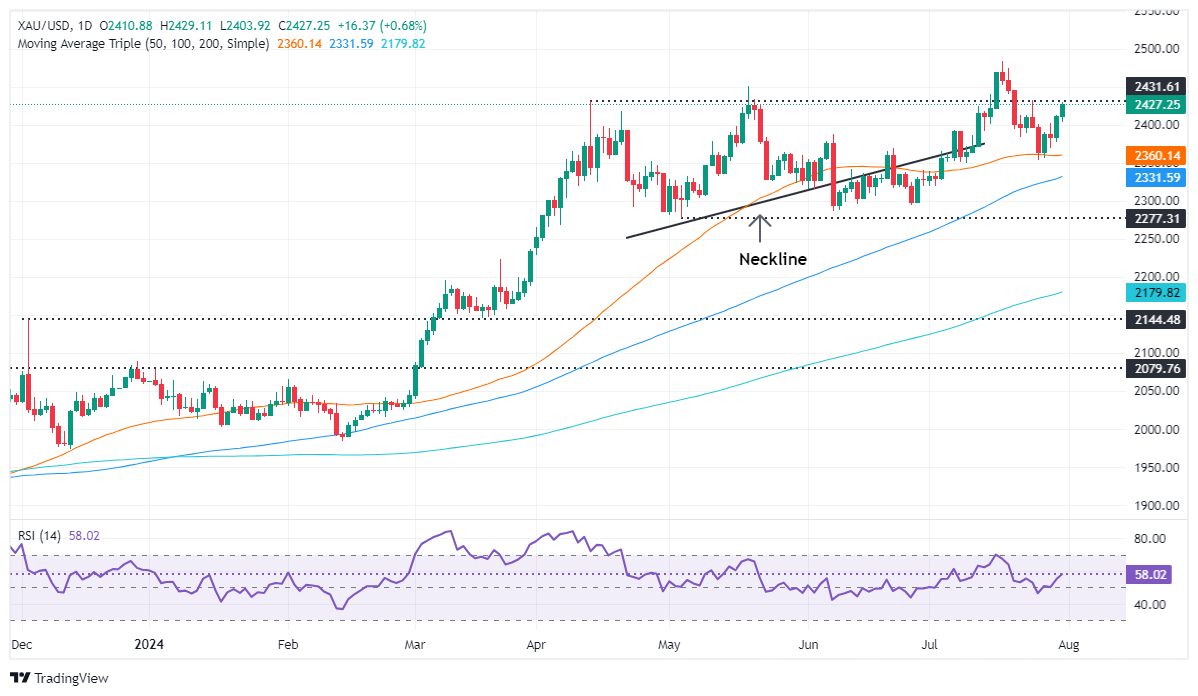- Gold price jumps over 1.50% after Fed holds rates steady.
- Powell highlights growing importance of US jobs data, with Nonfarm Payrolls report pivotal.
- US Dollar Index falls 0.42% as Treasury yields drop, driven by Fed's balanced view on inflation and employment.
Gold price rallied sharply late in the North American session after the Federal Reserve decided to hold rates unchanged. Fed Chairman Jerome Powell hinted that US jobs data would begin to play a crucial role in setting monetary policy. The XAU/USD trades at $2,447, gaining more than 1.50%.
Wall Street trades with gains following Powell’s press conference. He said the disinflation process has “broadened” and recognized downside risks in the labor market. Powell added, “We don't think of the labor market as it is currently as a likely source of inflation pressures,” and stated that if they see a job market downturn, “we should respond.”
Following these remarks, Friday’s July Nonfarm Payrolls report will be a crucial piece of the puzzle as the Fed pivots towards becoming more concerned about employment. Following Powell’s remarks, market participants have priced in 70 basis points (bps) of interest rate cuts towards the end of the year.
In its monetary policy statement, Fed officials noted, “The Committee does not expect it will be appropriate to reduce the target range until it has gained greater confidence that inflation is moving sustainably toward 2 percent.” They acknowledged that, despite easing, inflation remains “somewhat elevated” and stated that the risks associated with the dual mandate have become more balanced.
After Powell’s press conference, US Treasury bond yields fell steeply, with the US 10-year benchmark note rate at 4.066%, down almost eight basis points, undermining the Greenback. The US Dollar Index (DXY), which tracks the buck’s performance against six other currencies, dropped 0.42% to 104.03.
Bullion prices witnessed a jump due to rising geopolitical risks following Hezbollah’s weekend attack on Israel, which retaliated this week and killed Hamas leader Ismail Haniyeh in Iran. According to Kyle Rodda, Capital.com market analyst, there has been safe-haven demand for Gold due to Middle East developments.
The US economic schedule revealed that private hiring decelerated in July, according to the Automatic Data Procession (ADP) Employment Change report. Aside from this, Building Permits improved following May’s plunge, while the Employment Cost Index (ECI), sought by the Fed as a measure of inflationary pressures in wages, dipped in the second quarter of 2024.
Daily digest market movers: Gold price as data justifies Fed rate cut
- The US ADP Employment Change in July showed that private hiring rose by 122K, below the estimated 150K and missing the 155K created in June.
- The Employment Cost Index (ECI) decelerated from 1.2% to 0.9% QoQ, below the forecast of 1%.
- Pending Home Sales in the US increased by 4.8% MoM in June, exceeding estimates of 1.5% growth following May’s -1.9% decline.
- The CME FedWatch tool shows that the central bank will reduce interest rates by 25 basis points (bps) from their current levels in the September meeting.
- Traders are also eyeing the release of the July ISM Manufacturing Purchasing Managers’ Index (PMI) and Nonfarm Payrolls (NFP), which will be published on Thursday and Friday, respectively.
Technical analysis: Gold price consolidates above $2,400
According to XAU/USD’s daily chart, the uptrend remains intact, though buyers are taking a respite as the non-yielding metal trades sideways at around $2,400. As measured by the Relatives Strength Index (RSI), momentum favors buyers, though economic news and geopolitical risks could move Gold prices.
If XAU/USD climbs past $2,450, the next resistance would be the all-time high at $2,483 ahead of the $2,500 figure. On the other hand, if Gold dips beneath $2,400, key support levels emerge.
The first support would be the July 30 low of $2,376, followed by the 50-day Simple Moving Average (SMA) at $2,359. Further losses lie underneath at the 100-day SMA at $2,331
Gold FAQs
Gold has played a key role in human’s history as it has been widely used as a store of value and medium of exchange. Currently, apart from its shine and usage for jewelry, the precious metal is widely seen as a safe-haven asset, meaning that it is considered a good investment during turbulent times. Gold is also widely seen as a hedge against inflation and against depreciating currencies as it doesn’t rely on any specific issuer or government.
Central banks are the biggest Gold holders. In their aim to support their currencies in turbulent times, central banks tend to diversify their reserves and buy Gold to improve the perceived strength of the economy and the currency. High Gold reserves can be a source of trust for a country’s solvency. Central banks added 1,136 tonnes of Gold worth around $70 billion to their reserves in 2022, according to data from the World Gold Council. This is the highest yearly purchase since records began. Central banks from emerging economies such as China, India and Turkey are quickly increasing their Gold reserves.
Gold has an inverse correlation with the US Dollar and US Treasuries, which are both major reserve and safe-haven assets. When the Dollar depreciates, Gold tends to rise, enabling investors and central banks to diversify their assets in turbulent times. Gold is also inversely correlated with risk assets. A rally in the stock market tends to weaken Gold price, while sell-offs in riskier markets tend to favor the precious metal.
The price can move due to a wide range of factors. Geopolitical instability or fears of a deep recession can quickly make Gold price escalate due to its safe-haven status. As a yield-less asset, Gold tends to rise with lower interest rates, while higher cost of money usually weighs down on the yellow metal. Still, most moves depend on how the US Dollar (USD) behaves as the asset is priced in dollars (XAU/USD). A strong Dollar tends to keep the price of Gold controlled, whereas a weaker Dollar is likely to push Gold prices up.
Information on these pages contains forward-looking statements that involve risks and uncertainties. Markets and instruments profiled on this page are for informational purposes only and should not in any way come across as a recommendation to buy or sell in these assets. You should do your own thorough research before making any investment decisions. FXStreet does not in any way guarantee that this information is free from mistakes, errors, or material misstatements. It also does not guarantee that this information is of a timely nature. Investing in Open Markets involves a great deal of risk, including the loss of all or a portion of your investment, as well as emotional distress. All risks, losses and costs associated with investing, including total loss of principal, are your responsibility. The views and opinions expressed in this article are those of the authors and do not necessarily reflect the official policy or position of FXStreet nor its advertisers. The author will not be held responsible for information that is found at the end of links posted on this page.
If not otherwise explicitly mentioned in the body of the article, at the time of writing, the author has no position in any stock mentioned in this article and no business relationship with any company mentioned. The author has not received compensation for writing this article, other than from FXStreet.
FXStreet and the author do not provide personalized recommendations. The author makes no representations as to the accuracy, completeness, or suitability of this information. FXStreet and the author will not be liable for any errors, omissions or any losses, injuries or damages arising from this information and its display or use. Errors and omissions excepted.
The author and FXStreet are not registered investment advisors and nothing in this article is intended to be investment advice.
Recommended content
Editors’ Picks

EUR/USD rose to fresh highs around 1.1240
EUR/USD maintained its bullish momentum on Thursday, climbing to the 1.1240 region as the US Dollar accelerated its decline amid growing concerns about the economic fallout from Trump's tariffs.

GBP/USD picks up pace, challenges 1.3000
GBP/USD made significant gains, edging just pips shy of the psychological 1.3000 barrier. The advance came amid trade war jitters and a sharp sell-off in the Greenback following the announcement of 145% US tariffs on China.

Gold flirts with record peaks near $3,175, Dollar tumbles
Gold continued its record-setting rally on fresh tariff-related headlines, surging past the $3,170 mark per troy ounce after the White House confirmed new tariffs, sparking another round of US Dollar selling.

Cardano stabilizes near $0.62 after Trump’s 90-day tariff pause-led surge
Cardano stabilizes around $0.62 on Thursday after a sharp recovery the previous day, triggered by US Donald Trump’s decision to pause tariffs for 90 days except for China and other countries that had retaliated against the reciprocal tariffs announced on April 2.

Trump’s tariff pause sparks rally – What comes next?
Markets staged a dramatic reversal Wednesday, led by a 12% surge in the Nasdaq and strong gains across major indices, following President Trump’s unexpected decision to pause tariff escalation for non-retaliating trade partners.

The Best brokers to trade EUR/USD
SPONSORED Discover the top brokers for trading EUR/USD in 2025. Our list features brokers with competitive spreads, fast execution, and powerful platforms. Whether you're a beginner or an expert, find the right partner to navigate the dynamic Forex market.




